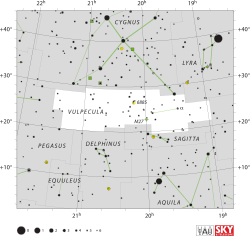16 Vulpeculae
| 16 Vulpeculae | |
 | |
| Observationsdata Epok: J2000.0 | |
|---|---|
| Stjärnbild | Räven |
| Rektascension | 20t 02m 01,43152s[1] |
| Deklination | +24° 56′ 16,9534″[1] |
| Skenbar magnitud () | +5,787 (V)[2] (5,93 +6,22)[3], +5,23 (V)[4] |
| Stjärntyp | |
| Spektraltyp | F2 III[5] |
| U–B | +0,10[6] |
| B–V | 0,374 ± 0,006[7] |
| Astrometri | |
| Radialhastighet () | -37,00 ± 3,7[8] km/s |
| Egenrörelse (µ) | RA: 89,31 ± 0,30[1] mas/år Dek.: 69,44 ± 0,32[1] mas/år |
| Parallax () | 14,71 ± 0,50[1] |
| Avstånd | 222 ± 8 lå (68 ± 2 pc) |
| Absolut magnitud () | 2,47[9] |
| Detaljer | |
| Massa | 1,34[10] M☉ |
| Radie | 4,03[4] R☉ |
| Luminositet | 31,13[11] L☉ |
| Temperatur | 6 888 ± 234[10] K |
| Metallicitet | +0,17 (Fe/H)[12] dex |
| Vinkelhastighet | 136,1 ± 6,8[9] km/s |
| Ålder | 742[10] miljarder år |
| Andra beteckningar | |
| HR 7657[13], IRAS 19599+2447[13], 2MASS J20020146+2456167[13], HD 190004[13], HIP 98636[13], SAO 88098[13], GSC 02145-01661[13], ADS 13277 AB[13], BD+24 3977[13], CCDM J20020+2456AB[13], GC 27768[13], GCRV 12385[13], HIC 98636[13], IDS 19578+2439 AB[13], PPM 110260[13], ROT 2899[13], TD1 25916[13], UBV 17114[13], uvby98 100190004[13], WDS J20020+2456AB[13], YZ 24 7430[13], UCAC4 575-102634[13], WEB 17446[13], 16 Vul, TIC 117237284[13] och AG+24 2126[13][14][10] | |
16 Vulpeculae, som är stjärnans Flamsteed-beteckning, är en dubbelstjärna belägen i den mellersta delen av stjärnbilden Räven.[1] Den har en kombinerad skenbar magnitud på ca 5,79[2] och är svagt synlig för blotta ögat där ljusföroreningar ej förekommer. Baserat på parallaxmätning inom Hipparcosuppdraget på ca 14,7[1] mas, beräknas den befinna sig på ett avstånd av ca 222 ljusår (ca 68 parsek) från solen. Den rör sig närmare solen med en heliocentrisk radialhastighet av ca -37 km/s[8] och kommer som närmast solen att vara på ett avstånd av 155 ljusår om ca 0,9 miljoner år.[11]
Egenskaper[redigera | redigera wikitext]
Primärstjärnan 16 Vulpeculae A är en gul till vit jättestjärna av spektralklass F2 III.[15] Den har en massa som är ca 1,3[10] solmassor, en radie som är ca 4,0[4] solradier och utsänder ca 31[11] gånger mera energi än solen från dess fotosfär vid en effektiv temperatur på ca 6 900 K.[10] Stjärnan har snabb rotation med en projicerad rotationshastighet på 136 km/s,[9] vilket ger den en något tillplattad form med en ekvatorialradie som uppskattas vara 21 procent större än polarradien.[16]
Stjärnorna i paret kretsar kring varandra med en beräknad omloppsperiod på 1 201 år och en excentricitet på 0,932.[17]
Referenser[redigera | redigera wikitext]
- Den här artikeln är helt eller delvis baserad på material från engelskspråkiga Wikipedia, 16 Vulpeculae, 9 september 2020.
Noter[redigera | redigera wikitext]
- ^ [a b c d e f g] van Leeuwen, F.; et al. (2007). "Validation of the new Hipparcos reduction". Astronomy and Astrophysics. 474 (2): 653–664. arXiv:0708.1752. Bibcode:2007A&A...474..653V. doi:10.1051/0004-6361:20078357.
- ^ [a b] Høg, E.; et al. (2000). "The Tycho-2 catalogue of the 2.5 million brightest stars". Astronomy and Astrophysics. 355: L27–L30. Bibcode:2000A&A...355L..27H.
- ^ Eggleton, P. P.; Tokovinin, A. A. (September 2008), "A catalogue of multiplicity among bright stellar systems", Monthly Notices of the Royal Astronomical Society, 389 (2): 869–879, arXiv:0806.2878, Bibcode:2008MNRAS.389..869E, doi:10.1111/j.1365-2966.2008.13596.x.
- ^ [a b c] ”16 Vulpeculae” (på engelska). Universe Guide. https://www.universeguide.com/star/16vulpeculae. Läst 7 juli 2019.
- ^ Cowley, Anne; Fraquelli, Dorothy (1974), "MK Spectral Types for Some Bright F Stars", Publications of the Astronomical Society of the Pacific, 86 (509): 70, Bibcode:1974PASP...86...70C, doi:10.1086/129562
- ^ Mermilliod, J.-C. (1986). "Compilation of Eggen's UBV data, transformed to UBV (unpublished)". Catalogue of Eggen's UBV Data. Bibcode:1986EgUBV........0M.
- ^ van Leeuwen (2007). ”Hipparcos, the New Reduction” (på engelska). http://vizier.u-strasbg.fr/viz-bin/VizieR-5?-out.add=.&-source=I/311/hip2&HIP=98636. Läst 7 juli 2019.
- ^ [a b] Holmberg, J.; et al. (2007), "The Geneva-Copenhagen survey of the Solar neighbourhood. II. New uvby calibrations and rediscussion of stellar ages, the G dwarf problem, age-metallicity diagram, and heating mechanisms of the disk", Astronomy & Astrophysics, 475 (2): 519–537, arXiv:0707.1891, Bibcode:2007A&A...475..519H, doi:10.1051/0004-6361:20077221.
- ^ [a b c] Ammler-von Eiff, M.; Reiners, A. (June 2012), "New measurements of rotation and differential rotation in A-F stars: are there two populations of differentially rotating stars?", Astronomy & Astrophysics, 542: A116, arXiv:1204.2459, Bibcode:2012A&A...542A.116A, doi:10.1051/0004-6361/201118724.
- ^ [a b c d e f] David, Trevor J.; Hillenbrand, Lynne A. (2015), "The Ages of Early-Type Stars: Strömgren Photometric Methods Calibrated, Validated, Tested, and Applied to Hosts and Prospective Hosts of Directly Imaged Exoplanets", The Astrophysical Journal, 804 (2): 146, arXiv:1501.03154, Bibcode:2015ApJ...804..146D, doi:10.1088/0004-637X/804/2/146.
- ^ [a b c] Anderson, E.; Francis, Ch. (2012), "XHIP: An extended hipparcos compilation", Astronomy Letters, 38 (5): 331, arXiv:1108.4971, Bibcode:2012AstL...38..331A, doi:10.1134/S1063773712050015.
- ^ Casagrande, L.; et al. (2011), "New constraints on the chemical evolution of the solar neighbourhood and Galactic disc(s). Improved astrophysical parameters for the Geneva-Copenhagen Survey", Astronomy & Astrophysics, 530 (A138): 21, arXiv:1103.4651, Bibcode:2011A&A...530A.138C, doi:10.1051/0004-6361/201016276.
- ^ [a b c d e f g h i j k l m n o p q r s t u v w x y] SIMBAD Astronomical Database.[källa från Wikidata]
- ^ ”Basic data: V* 16 Vul – Double or multiple star” (på engelska). Centre de Données astronomiques de Strasbourg. http://simbad.u-strasbg.fr/simbad/sim-basic?Ident=16+Vul&submit=SIMBAD+search. Läst 7 juli 2019.
- ^ "* 16 Vul". SIMBAD. Centre de données astronomiques de Strasbourg. Hämtad 20 augusti 2017.
- ^ Belle, G. T. (2012), "Interferometric observations of rapidly rotating stars", The Astronomy and Astrophysics Review, 20 (1): 51, arXiv:1204.2572, Bibcode:2012A&ARv..20...51V, doi:10.1007/s00159-012-0051-2.
- ^ "Sixth Catalog of Orbits of Visual Binary Stars". United States Naval Observatory. Hämtad 24 augusti 2017.





